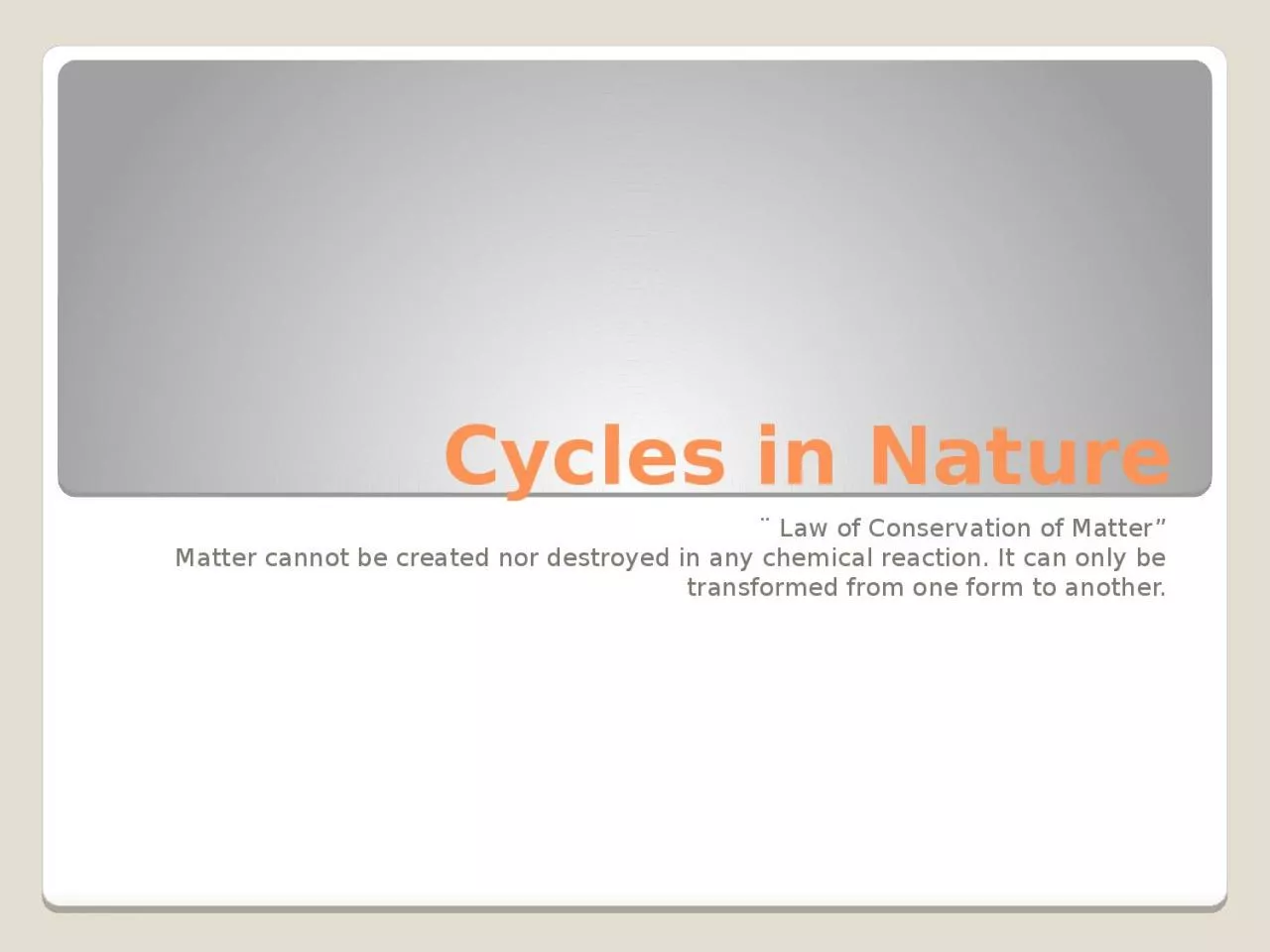

Matter Matter cannot be created nor destroyed in any chemical reaction It can only be transformed from one form to another Cycle A cycle shows the reusing of certain elements and compounds eg ID: 1022635
Download Presentation The PPT/PDF document "Cycles in Nature ¨ Law of Conservation ..." is the property of its rightful owner. Permission is granted to download and print the materials on this web site for personal, non-commercial use only, and to display it on your personal computer provided you do not modify the materials and that you retain all copyright notices contained in the materials. By downloading content from our website, you accept the terms of this agreement.
1. Cycles in Nature¨ Law of Conservation of Matter”Matter cannot be created nor destroyed in any chemical reaction. It can only betransformed from one form to another.
2. CycleA cycle shows the reusing of certain elements and compounds (e.g. water, carbon, oxygen, nitrogen, phosphorus) in different forms in ecosystems.
3. Water CycleThe sun provides the heat energy required for the cycle to continue.The oceans and rivers are the main reservoirs of water.
4. Water CycleEvaporation – Water evaporates into the atmosphere.Condensation – Water condenses into droplets in the clouds.Precipitation – As the water droplets in clouds enlarge, water falls to earth in the form of rain, snow or hail.Transpiration – Water is lost through the leaves of plants (‘trees perspiring’).
5. Water Cycle
6. Carbon CycleCarbon occurs in all living organisms in the forms of carbon dioxide, carbohydrates (sugars and starches), proteins and fats.Oxygen occurs in all living organisms in the forms of oxygen gas, water, carbon dioxide, carbohydrates, proteins and fats.
7. PhotosynthesisPhotosynthesis – Photosynthesis is the process used by plants containing chlorophyll to utilize sunlight, carbon dioxide and water to form sugar (as glucose) and oxygen. Sunlight Carbon + Water ---------Glucose + Oxygen Dioxide Chlorophyll Sugar Sunlight CO2 + H2O ----------- C6H12O6 + O2 Chlorophyll
8. RespirationRespiration – Respiration is the process that most living organisms (including animals, plants, fungi and micro-organisms) use to obtain energy from glucose sugar and oxygen. The wastes formed are carbon dioxide and water. Glucose + Oxygen ------------------ Carbon + Water+Energy DioxideC6H12O6 + O2 ----------------- CO2 + H2O +Energy
9. Carbon CycleNutrition – Living organisms contain a large quantity of carbon in the form of carbohydrates, proteins, and so on. When one organism eats another, that carbon is passed from one organism to another. Decomposition – Almost all living organisms require oxygen. When decomposing bacteria and fungus break down dead organisms and their wastes such as feces, they take in oxygen and release carbon dioxide into the atmosphere. Combustion – The reactions of living matter produces carbon dioxide and water.
10. Carbon Cycle
11. Nitrogen CycleThere are two interrelated parts of the Nitrogen Cycle.First Part of the Nitrogen Cycle Nitrogen gas forms about 80% of the atmosphere. However, no animals and few plants can utilize nitrogen in this gaseous form.Nitrogen-Fixing Bacteria converts atmospheric nitrogen to amino acids, which are the components of proteins. Examples of nitrogen-fixing bacteria are the cyanobacteria Nostoc, soil bacteria Azotobacter and Clostridium, and the legume root bacteria Rhizobium.Atmospheric nitrogen can also be fixed or converted to a more solid form by lightning.In reverse, Denitrifying Bacteria in the soil convert ammonia, a nitrogenous waste in urine, back to atmospheric nitrogen.
12. Nitrogen CycleSecond Part of the Nitrogen CycleNitrogen in animals and plants is in the form of amino acids and proteins. As one organism eats another along the food chain, the nitrogen passes from one organism to another.Animals also excrete nitrogenous wastes in urine as urea, uric acid or ammonia. This passes to the soil.When animals and plants die, Putrefactive Bacteria in the soil converts the body amino acids and proteins to ammonia in the soil. These decay bacteria also convert urea and uric acid to ammonia in the soil.Nitrite Bacteria in the soil convert ammonia to nitrites in the soil.Nitrate Bacteria in the soil convert those nitrites to nitrates in the soil. These are used by the plants as fertilizers.
13. Nitrogen Cycle
14. Phosphorus Cycle Phosphorus is an essential component of many chemicals within living organisms. Examples include the energy-rich compound ATP (Adenosine Triphosphate) and the phosphates used by plants as fertilizers.Phosphorus cycles in a complex way which is different from the elements of carbon, oxygen and nitrogen. Phosphorus in the form of phosphates is deposited as feces and guano on land masses such as the island of Nauru. Rain then erodes the phosphorus-rich guano into the ocean. The guano then is eroded further in the ocean. There is little deposition back onto the land.
15. Phosphorus Cycle
16. DID YOU KNOW…Did You Know That…? Atoms of carbon and oxygen that were part of Leonardo da Vinci's body could be in your body right now.